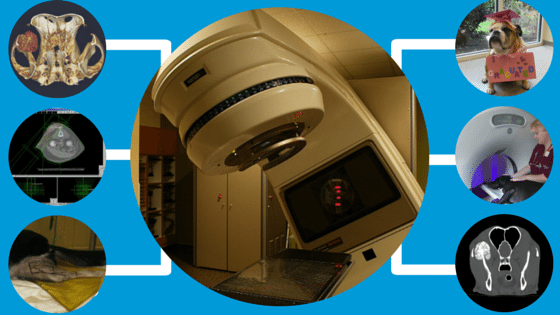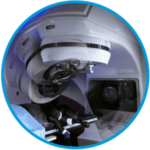
For most of us in the veterinary field, radiation therapy is a mysterious treatment that occurs elsewhere or it is a modality that a family member or friend underwent. However, because it is so effective in treating people with cancer (and with the guidance of Dr. Google), more and more clients are asking about the use of this treatment in their pets. For many of us, we really haven’t been trained on how to discuss this treatment option with clients. So, I wanted to go over some of the nuts and bolts of what clients can expect when choosing radiation therapy for their pet. A number of parameters are evaluated to determine if radiation therapy can benefit a patient and what course of radiation therapy is most appropriate. These variables can include: expected outcome, tumor responsiveness, tumor location, presence of microscopic versus macroscopic disease, machine and software capability, and if concurrent or follow-up treatments are planned.

At its most basic, radiation therapy involves repeatedly subjecting a tumor to a beam of high energy x-rays over a number of days or weeks. Radiation works by damaging the DNA of affected cells, leading to cell death. Because radiation is not selective about healthy or neoplastic cells, the goal is to target as many tumor cells as possible with this high energy radiation while avoiding damage to the normal surrounding tissue. So, how do we avoid damage to healthy cells?
Using live video communications, our medical oncologists and surgeons consult with our radiation oncologist, Dr. William Ratterree, to determine a treatment plan for each patient’s tumor. The following steps outline the planning process.

Radiation therapy is a very adaptable form of therapy and no two treatment plans are alike. However, in broad terms, we have two main categories of treatment plans- definitive and palliative radiation.
Definitive
Side Effects
Side effects of radiation therapy are dependent on the course of radiation applied, location, and size of the radiation treatment area. Tumor response is closely monitored by our oncology team during and after treatments to optimally deal with any problems that may arise. There are two types of side effects:
• Acute side effects occur in tissues that have a normal rapid cell turnover, like epithelial linings (skin, mucous membranes, GI tract), and generally start during the second half of therapy and last for 1-2 weeks after therapy is complete.
• Late side effects occur in tissues where cells divide slowly and infrequently, such as bone and nervous tissue. These side effects do not generally occur until 6 months to 1 year after completion when the cells attempt to divide but instead die due to DNA damage. For these reasons, late side effects do not typically heal and can cause significant issues. Preventative measures to avoid these effects are very important, especially in patients where long term survival is possible. These preventative measures include reducing patient movement during the procedure by using positioning devices and creating radiation plans that target tumor tissue while avoiding as much normal tissue as possible.

Anesthesia
Tailoring sedation and anesthesia protocols to the needs of the patient minimizes anesthesia risks. All patients have an IV catheter in place, receive fluids during anesthesia and are monitored by a licensed veterinary technician (LVT). While the majority of our patients are older, they generally tolerate the short anesthetic episodes. Each treatment takes about 20-30 minutes after the initial set-up day.
Cost
Delivering the news to a client that their beloved family pet has cancer is never easy. In addition, discussing treatment options and cost can be just as difficult and escalate an already stressful situation. Will their pet need surgery, chemotherapy, and/or radiation to treat the tumor? These questions make it tough for you to provide an accurate estimate and can potentially leave clients feeling overwhelmed and helpless. All treatment plans are unique to each patient and during a consultation our oncologists can provide your client with an accurate estimate. As always, please do not hesitate to call me or Dr. Fulmer so we can guide you with potential treatment recommendations and cost.
Quick Facts:
 While radiation therapy is an involved modality it also an extremely effective treatment for many of our veterinary tumors. Should you have any patients who you feel might benefit from radiation in the management of their tumor feel free to reach out to us here and we will be happy to help you with making treatment decisions and recommendations.
While radiation therapy is an involved modality it also an extremely effective treatment for many of our veterinary tumors. Should you have any patients who you feel might benefit from radiation in the management of their tumor feel free to reach out to us here and we will be happy to help you with making treatment decisions and recommendations.
Good review articles to consider for more information regarding RT are listed below:
Veterinary radiation therapy: review and current state of the art. McEntee MC. Journal of American Animal Hospital Association 2006;42(2):94-109
Radiation therapy for the treatment of tumours in small companion animals. Moore AS. Veterinary Journal 2002;164(3):176-87